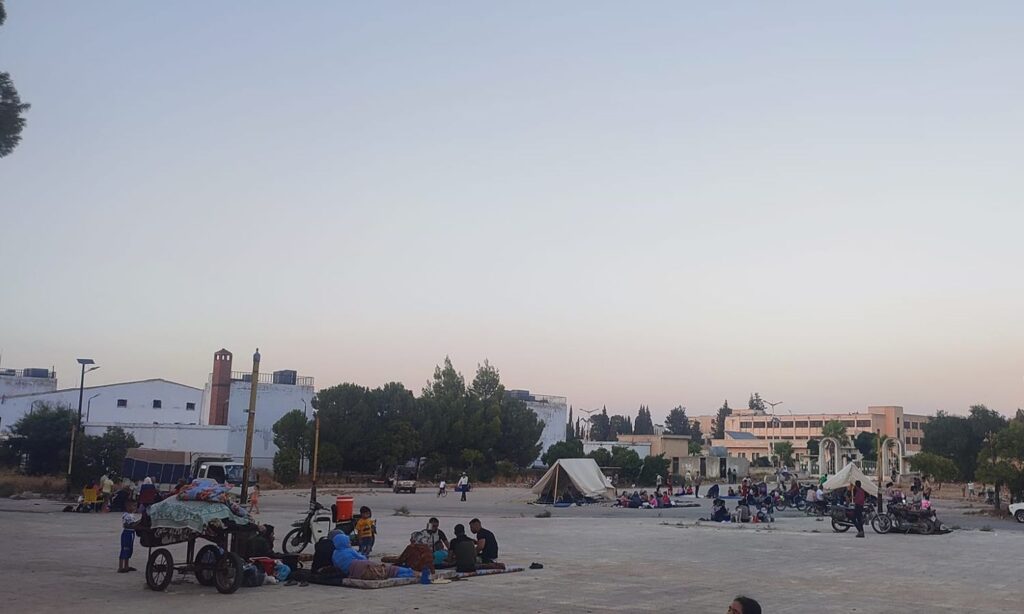A week ago, an earthquake exceeding five on the Richter scale struck Syria, centering east of Hama governorate, near a small village called Tal al-Durra, which administratively belongs to the Salamiya area, about seven kilometers west.
Today, with days passing since the earthquake, the people of Salamiya still spend their time on the streets due to the fear that gripped the residents during the earthquake, avoiding a repeat of the scenario, according to some who spoke to Enab Baladi.
The earthquake coincided with an outage of home internet in the city, making it difficult for those away from the city to obtain information about their families inside the city.
Fear drives residents to the streets
The first earthquake on August 13 injured 17 people with minor injuries along with panic that spread throughout nearby Syrian cities to the earthquake’s center, pushing residents to seek ways to avoid repeating the scenario of fear they lived through.
The official Syrian news agency (SANA) reported at the time from the director of Salamiya National Hospital, Osama Milhem, that 12 people were taken to the hospital with injuries and bruises on their bodies due to rushing and falling while hastily leaving their homes.
Additionally, five people were taken to the hospital after suffering panic and nervous breakdowns due to the earthquake, with necessary first aid and treatment provided to them.
Hadi, a 32-year-old resident of Salamiya, told Enab Baladi that the moment of the earthquake drove most of the city’s residents into the streets, including him.
Hadi was roaming the city to check on his relatives, especially since the internet and electricity were also cut off.
Ismail, also from Salamiya, was trying to reach his pregnant sister’s house in the eastern part of the city after getting his family out of the house, affected by the shock of the seconds during which the earthquake struck the city.
Today, a week after the earthquake, the city’s residents still spend their evenings in the streets or public parks, while volunteer teams and condolence organizing companies that own tents allow civilians to stay in them for free.
Through closed groups created by the city’s residents on the WhatsApp application, young people from the city communicated with others living in Europe to form a link between them and their families, especially with the home internet cut off from the city.
Tent near the house
At central gathering points, the Ismaili Supreme Council set up tents for the city people who left their homes to spend the night in, escaping their fears of the earthquake and aftershocks that still continue today.
In al-Ziraea Park, some tents were erected, and volunteers set up a projector to entertain children at night, according to what Hadi and Ismail told Enab Baladi. Children’s programs like Tom and Jerry have gathered both young and old in the same park.
Tents have spread to dozens of places within the city, especially in vacant areas such as parks, public squares, in the Qibla neighborhood, around the specialized hospital, and other such places.
Volunteer teams have been active in providing awareness courses on how to act in the event of an earthquake. Most of these teams, being local, also provided entertainment activities for children.
Hadi told Enab Baladi that the Ismaili Aga Khan Foundation equipped the tents with essentials such as mattresses, drinking water, lighting, and more, as he takes his family to the tent located meters away from his house to spend the night.
Other volunteer teams, specializing in rescue, have also been active in the streets at night in case of aftershocks or a new earthquake.
Repeated tremors
The observation stations at the National Earthquake Center recorded six new tremors of varying intensity with different epicenters in the last 24 hours, all classified as mild tremors.
On August 16, the National Earthquake Center in Syria (based in Damascus) announced the occurrence of a tremor four kilometers west of Salamiya, in Hama governorate, central Syria, for the second time in less than a week.
The Euro-Mediterranean Seismological Center said the tremor measured 5.2 degrees and occurred 22 kilometers east of Hama.
According to the National Earthquake Center, the tremor measured 4.9 degrees on the Richter scale and 28 kilometers east of Hama.
Lebanese media outlets reported that residents of Beirut, Jbeil, and Keserwan felt the tremor.
On August 13, the official Syrian news agency (SANA) reported that an earthquake with a magnitude of 5.5 on the Richter scale struck east of Hama city, about 28 kilometers, specifically Salamiya city.
The agency quoted the National Earthquake Center, stating that the tremor’s depth was 3.9 kilometers.
The earthquake was felt by residents in several Syrian provinces, reaching northwestern Syria, causing a panic that drove some residents to take to the streets fearing potential aftershocks.
In this context, the president of the Syrian Association for Basic and Natural Sciences, Nidal Jouneh, said that the region is now heading towards stability and reduced seismic activity, according to the National Earthquake Center recordings, indicating no signs suggesting a possible devastating earthquake.

